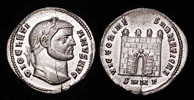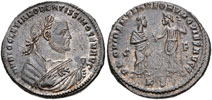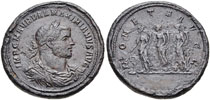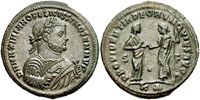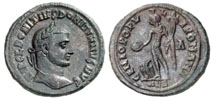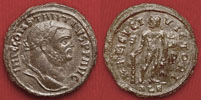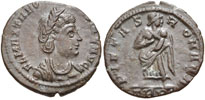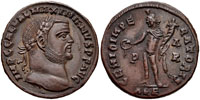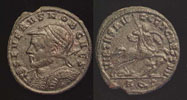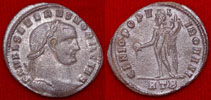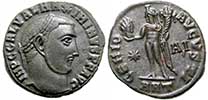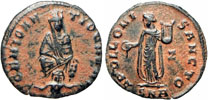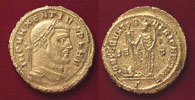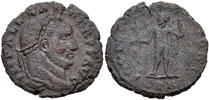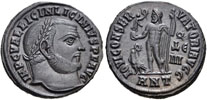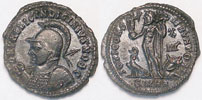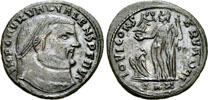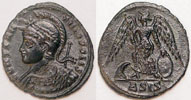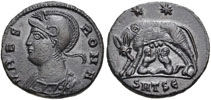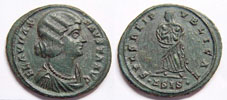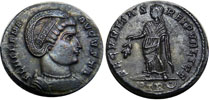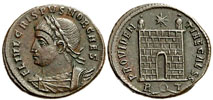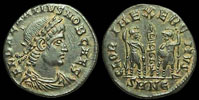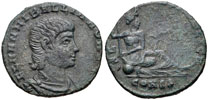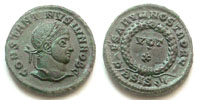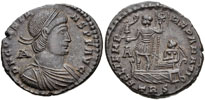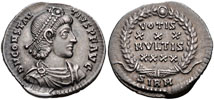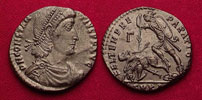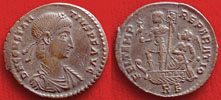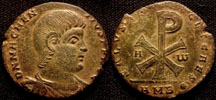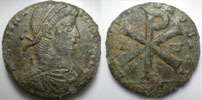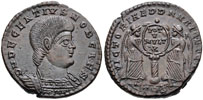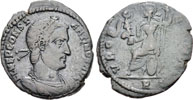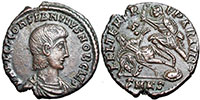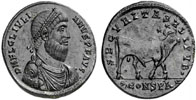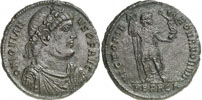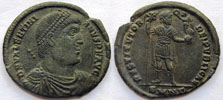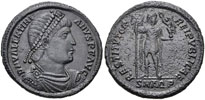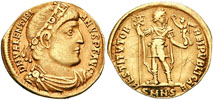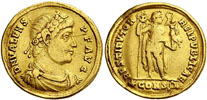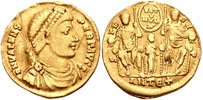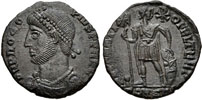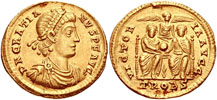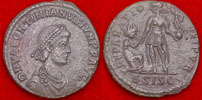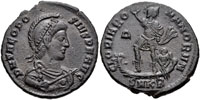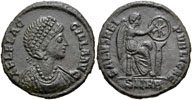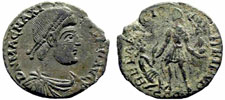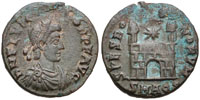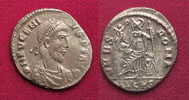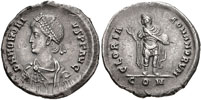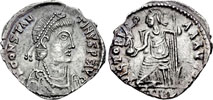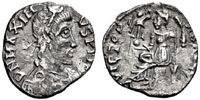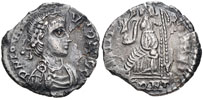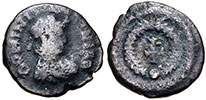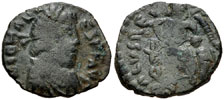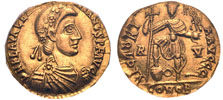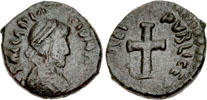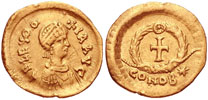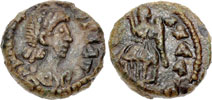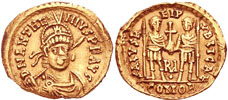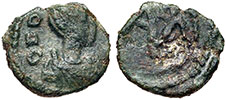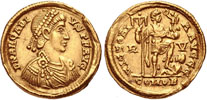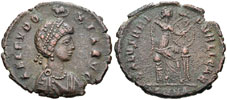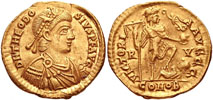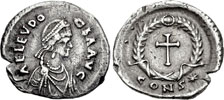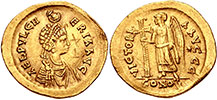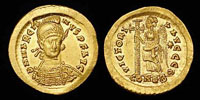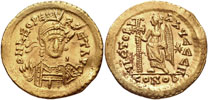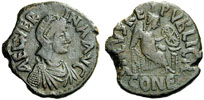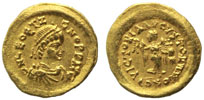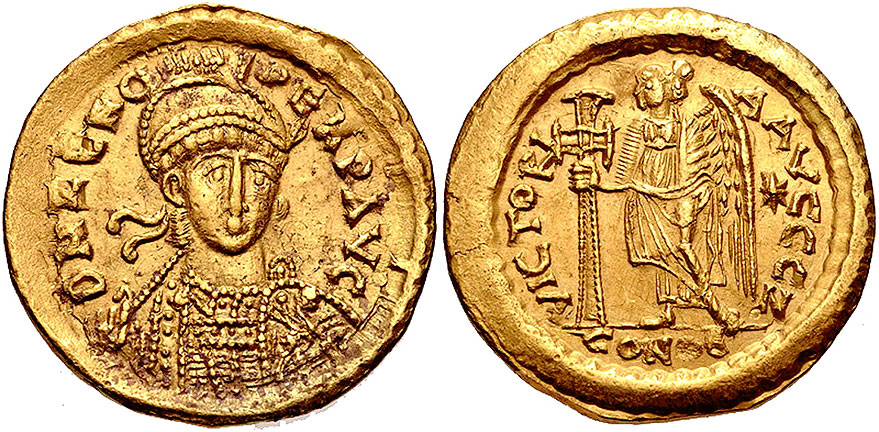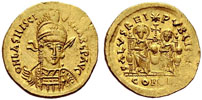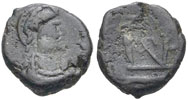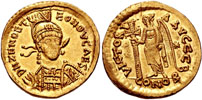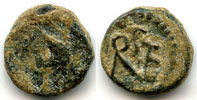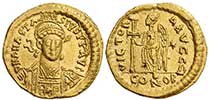(The 4th & 5th centuries)
Collection L - Reasonable Offers Welcome
THE TETRARCHY:
DIOCLETIAN, 284-305
7951. DIOCLETIAN, 284-305. AR Argentius. /Campgate. Superb example near FDC with full mint lustre with the near inevitable striking line. $650.
MAXIMIANUS (aka MAXIMIAN HERCULIUS), 286-305 (first reign), 306-308 (second reign), 310 (usurpation in Massilia)
AMANDUS, c. 285-286
DOMITIUS DOMITIANUS, c. 296-297 (usurper in Egypt)
CONSTANTIUS I CHLORUS, 293-306
10239. CONSTANTIUS I CHLORUS, 293-306. AE29 Large Follis. Reverse: Hercules standing. Good VF. Much better than photo with considerable silvering.
THEODORA (Flavia Maximiana Theodora), second wife of Constantius I Chlorus
CHILD? OF THEODORA AND CONSTANTIUS I CHLORUS
GALERIUS, 293-311
GALERIA VALERIA, (daughter of Diocletian, wife of Galerius)
SEVERUS II, 305-307
6644. SEVERUS II. Large module Follis. Cuirassed & helmeted bust with spear over shoulder/Horseman spearing soldier. AEF. Scarce. $350.
10327. SEVERUS II. Large module Follis. Laureate and draped bust right. Reverse: The genius of Rome. Choice EF example with full silvering. Rare this nice.
MAXIMINUS II DAIA, 305-313
CHRISTIAN PERSECUTION ISSUES, 310-313
MAXENTIUS, 306-312
ROMULUS, (son of Maxentius)
9515. SCARCE FINE STYLE PORTRAIT OF ROMULUS, died 309 AD, Follis, RIC 257v. /Domed mausoleum surmounted by eagle. Rome mint. VF. Scarce. $1000.
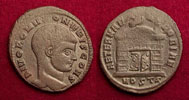
DOMITIUS ALEXANDER, 308-311 (usurper in Carthage)
LICINIUS I, 308-324
CONSTANTIA, (wife of Licinius, half-sister of Constantine)
LICINIUS JUNIOR, 317-324
VALERIUS VALENS (Aurelius Valerius Valens), briefly co-Augustus with Licinius, 314
MARTINIAN, briefly co-Augustus with Licinius, 324
11260. MARTINIAN, late July - 18th September 324 AD. AE Follis, RIC VII Nicomedia 45. 3.06 grams. Obv: DN M MARTINIANVS PF AVG, radiate, draped, cuirassed bust right. Rev: IOVI CONS-ERVATORI, Jupiter standing left, chlamys across left shoulder, holding Victory on globe and eagle-tipped sceptre eagle with wreath at foot left, captive right; X over II Mu in right field; Mintmark SMNA. Fine. R5, extremely rare. Another view. Martinian was the unfortunate who Licinius made his co-emperor in a moment of desperation following his defeat by Constantine at Adrianople on July 3, 324, under virtually identical circumstances to eight years before when Licinius had done the same disservice to Valerius Valens, who was executed after Licinius sued for peace. Martinianus was formerly the magister officorum (head of the civil service) to emperor. It is fortunate that coins were struck in Martinian's name, for their inscriptions provide him the title of Augustus - a contradiction to most of the literary sources, which only describe him as having held the subordinate rank of Caesar. The war quickly evolved on a disastrous path with Licinius no better prepared the second time to meet Constantine, who this time was determined to make his victory complete. The armies were enormous: the combined land forces exceeded 250,000 men and the seas were crowded with some 500 ships. From the first engagement Licinius was on the retreat, falling back to the Bosphorus and instructing Martinian to raise reinforcements and to prevent Constantine from crossing into Asia Minor. Unfortunately for Martinian and Licinius, Crispus, the eldest son of Constantine, won a spectacular naval battle and took command of the Sea of Marmara, thus allowing a flotilla to deliver Constantinian troops onto Asian soil. Eventually Licinius took refuge in Nicomedia with a fraction of his original army. His surrender was arranged by Constantia, who was trapped in the middle as the wife of Licinius, the mother of Licinius II, and the half-sister of Constantine. Though the lives of Licinius and his son were initially spared, Martinian was executed not long after he had been sent in exile to Cappadocia.
$2500.
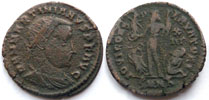
THE CONSTANTINIAN DYNASTY:
CONSTANTINE I, THE GREAT, 306-337
11321. CONSTANTINE'S CHRISTIAN VISION FROM HEAVEN. CONSTANTINE I, THE GREAT, Gold Medallion of 1 1/2 solidi (6.29 g) minted at Siscia, AD 326-327. Anepigraphic diademed bust right of Constantine the Great. Reverse: Emperor advancng right, holding military trophy, with left foot on captive and dragging another captive behind. RIC 206; C. 237. Smoothing in right obverse field. Sharpness of Extremely Fine. Provenance: Ex Gemini VIII 4/14/2011 ($16,675 hammer price); Ex NFA XIV (29 XI 84), lot 555; ex Hess-Leu 41 (24 IV 69), lot 565. A major rarity and one of the most important historical coins ever struck by the Romans. This medallion in which Constantine looks up to heaven commemorates Constantine's famous vision of a Christian Chi Rho cross symbol in the sky before the battle against his stronger rival Maxentius at the Milvian bridge. Putting the Chi Rho symbol on his banners he was victorious over Maxentius and as a result converted to Christianity and made it the official religion of Rome thus ending centuries of repression of the Christians. This single event in turn resulted in Christianity spreading throughout Europe and becoming one of the major driving forces of European history up till the present.
There have been various explanations of Constantine's vision. One of the most convincing is a sizable meteorite known to have smashed into an Italian valley in the Sirente plain not far away at about the time of the battle. It is speculated that the trail from the meteorite would have been easily visible over the battleground and might have formed contortions resembling a Chi Rho cross as it broke up. Certainly it would have been taken as a miraculous sign from heaven by Constantine and his army.
Note: Though it is well known this coin depicts Constantine looking towards heaven it is invariably pictured oriented with him looking straight ahead. The proper orientation should be something like this.
SOLD.
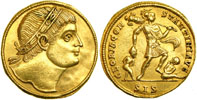
ANONYMOUS ISSUES COMMEMORATING CONSTANTINOPLE & ROME, C. 330-346
FAUSTA, (daughter of Maximinanus, wife of Constantine I)
HELENA, (mother of Constantine I, first wife of Constantius I)
CRISPUS, 316-326, (son of Constantine I)
DELMATIUS, 335-337
HANNIBALLIANUS, 335-337, (King of Pontica, nephew of Constantine I)
CONSTANTINE II, 316-340
CONSTANS, 333-350
CONSTANTIUS II, 337-361
MAGNENTIUS, 350-353
POEMENIUS?, 352, (rebel in Trier)
DECENTIUS, 351-353, (brother of Magnentius)
NEPOTIAN, c. 350, (rebel against Magnentius)
VETRANIO, 350
9441. CHOICE EF VETRANIO, 350 AD. Centenionalis, HRIC 6. /Vetranio stg. with 2 Chi Rho standards. EF+. Choice sharp strike. 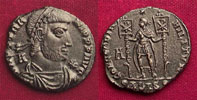
CONSTANTIUS GALLUS, 351-354
JULIAN II (The Apostate), 355-363
HELENA II, 360, wife of Julian II, daughter of Constantine I and Fausta.
JOVIAN, 363-364
THE WANING OF THE EMPIRE:
VALENTINIAN I, 364-375
VALENS, 364-378, (brother of Valentian I)
VALENTINIAN GALATES, 369, Consul Prior, only son of Valens
PROCOPIUS, 365-366, (usurper in the East)
GRATIAN, 367-383, (son of Valentinian I by Severa)
VALENTINIAN II, 375-392, (son of Valentinian I by Justina)
10396. VALENTINIAN II,
THEODOSIUS I, 379-395
AELIA FLACCILLA, (wife of Theodosius I)
MAGNUS MAXIMUS, 383-388, (usurper in the West)
FLAVIUS VICTOR, 387-388, (son of Magnus Maximus)
EUGENIUS, 392-394, (usurper in the West)
THE WESTERN PUPPET EMPERORS:
HONORIUS, 394-423, (son of Theodosius I, brother of Arcadius)
CONSTANTINE III, c. 407-411, (usurper in Gaul and Britain)
CONSTANS II, 408-411, (son of Constantine III)
MAXIMUS, 409-411, (usurper in Spain)
PRISCUS ATTALUS, 409-410, 414-415
JOVINUS, c. 411-413
SEBASTIANUS, c. 412-413, (brother of Jovinus)
CONSTANTIUS III, 421
BONIFATIUS (Bonifacius), 422-431, (semi-independent in Africa)
JOHANNES, 423-425
VALENTINIAN III, 425-455, (son of Constantius III and Galla Placidia)
GALLA PLACIDIA, (mother of Valentinian III, half-sister of Honorius & Arcadius)
LICINIA EUDOXIA, (wife of Valentinian III, then Petronius Maximus)
HONORIA, (sister of Valentinian III)
11437. HONORIA, sister of Valentinian III. 427 -, Ravenna. AV-tremissis. Diademed and draped bust r. Rev: Cross in wreath. Crawford 5; R.I.C. 2068. 1.48g, RR! Near VF.
PETRONIUS MAXIMUS, 455, (usurper in Rome)
AVITUS, 455-456
MAJORIAN, 457-461
LIBIUS SEVERUS (Severus III), 461-465
RICIMER, 457-472, Patrician and master of soldiers
ALYPIA, Augusta?, 467?-472?, wife of Ricimer. (Currently only a single coin depicting Alypia is known to exist, that being a solidus of her mother Euphemia with figures of Euphemia and Alypia on the reverse.)
ANTHEMIUS, 467-472
EUPHEMIA, (daughter of Marcian, wife of Anthemius)
OLYBRIUS, 472
GLYCERIUS, 473-474
GUNDOBAD, 472-474, nephew of Ricimer, master of soldiers
JULIUS NEPOS, 474-475
ROMULUS AUGUSTUS, 475-476
ODOVACAR (Flavius Odoacer, Flavius Odovacar), 476-493
THE EASTERN EMPERORS:
ARCADIUS, 383-408 (son of Theodosius I, brother of Honorius)
AELIA EUDOXIA, (daughter of Flavius Bauto, wife of Arcadius)
THEODOSIUS II, 402-450, (son of Arcadius)
AELIA EUDOCIA, (wife of Theodosius II)
PULCHERIA, (daughter of Arcadius & Eudoxia, sister and regent for Theodosius II, wife of Marcian)
MARCIAN, 450-457
7952. MARCIAN, 450-457. Gold Solidus of Constantinople, H2. His bust facing/Victory stg with long cross. EF. Choice example. Scarce!
LEO I, 457-474
AELIA VERINA, (wife of Leo I)
PATRICIUS, 470-471, caesar under Leo I
LEO II, 474, (son of Zeno, grandson of Leo I)
ZENO, 474-491, (father of Leo II)
ARIADNE, (wife of Zeno)
BASILISCUS, 474-475, (usurper in Constantinople)
MARCUS, 475-476, (Caesar and junior Augustus under Basiliscus)
AELIA ZENONIS, (wife of Basiliscus)
ZENO AND LEO, 476?, caesars, (sons of Basiliscus?)
LEONTIUS, 484-488, (usurper in Taurus and Isuaria)
ANASTASIUS I, 491-518
